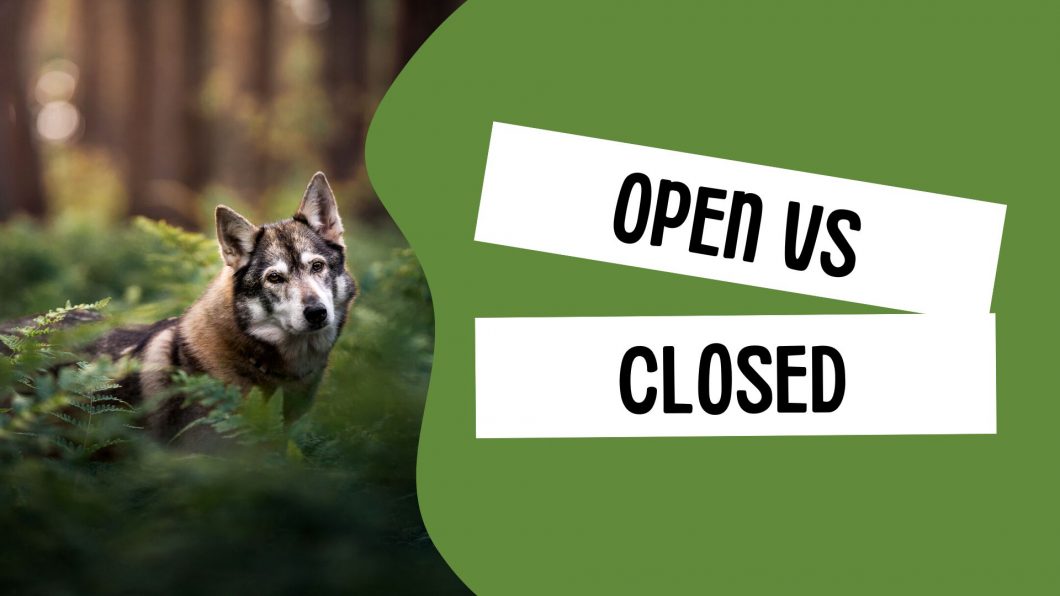The more I have been teaching photography, the more I have found that there seem to be two types of locations:
Open – where there is some space around the dog, the light is falling evenly, there are no or very few “elements” in the foreground or mid-ground onto which light can fall. Everything is quite level and even. Fields, snow, the beach, a yard, urban locations, etc all are quite open.

Then there are more “closed” locations – there there might be some kind of “environment” around the dog (could be man-made or natural), or some kind of foreground beyond the depth of field blur, or some element of visual interest near or around the dog.

In general, an “open” location is simpler, great for action photos or group portraits, where we may want a simpler, cleaner, and less distracting environment.
It will be simpler to edit, but those of us who are more advanced editors may find it strange that there is relatively little for us to do! If we try and do too much on these, the lighting often becomes strange very quickly, as there are no places which should be more shadowed or lit than others, due to the even fall of light.
We also experience a lot of “open” locations when it’s been snowing as our foreground and mid-ground plants have been squashed down, and the background is shades of white and grey. “Open” photos of headshots tend to feel like they’re lacking something, are a bit empty, or just don’t “pop”. This may be because there’s no context, and nothing interesting in the image except the dog.
Owners or clients often love “open” photos because the photo is 100% all about the dog. There’s nothing else going on. Nothing but dog. So as you make your way through the next lessons, remember, there is nothing wrong with open locations. They’re just probably not going to be as “interesting” as more closed locations/photos with context.
Personally, I prefer my photos having some kind of foreground beyond the simple depth of field created by being so low to the ground, and/or having some element of “visual interest” in/near/around the dog. For my photos, this grounds the dog within the scene, or provides context. It takes us from “simple portrait of a dog” to something more interesting.
Below are 4 examples.
On the left: “Open locations”. On the right, “Closed locations”.
The photos were each taken about 2 meters from the other. So for the first open location, I took the photo, moved Loki and I about 2 meters to the right, and took another photo. The headshot example was the same, but a shorter distance, and we moved left.
In each case, both photos are totally fine. There’s nothing wrong with either of them. I’d say that the “open” locations are simple portraits of a dog. There he is, very cute, nice dog, living his dog life. The “closed” locations give us more to work with. We can play with light more, create a story, have him interact in/with/around the location. The closed headshot I especially love. The way his face seems so soft compared to the sharp thorns of the brambles, the curl of the bramble-leaf against his cheek, as if it were caressing him…
Let’s have a look at a couple more examples. These photos aren’t anything special – they’re only lightly edited, taken late in the afternoon on a foggy day. Again, they were taken literally one meter apart from each “version” (one version with Loki, one with Journey). I posed each dog on the road, then took maybe 3 steps to the side, and posed them again.
The only difference in each is the “visual interest”. I was working in a very bare forest in the middle of winter, but I wanted to show that you can still use natural (or man made!) elements, without needing moss, rocks, ferns, or anything else particularly fancy.
Please excuse the image quality! ISO 3200 and LOTS of brightening in editing. I’ll redo them when I have a moment but I do think they work well to show a not very exciting background and how simply adding a tree trunk can make the image more interesting!
Below are some more examples. Each of them will show an “open” photo on the left – there may be DOF blur in the foreground, then the dog, then the background. On the right, I have tried to compare it to a “similar” photo – eg., same colours/light/pose, as much as possible, but with some other foreground and/or mid-ground layer/visual interest.
Neither one is necessarily “better” than the other, this is just to begin to look at some of the ways we may elevate our photography through choice of location. Many pet photographers may actually prefer the more open, simple locations because there are less distractions. It’s 100% dog.


